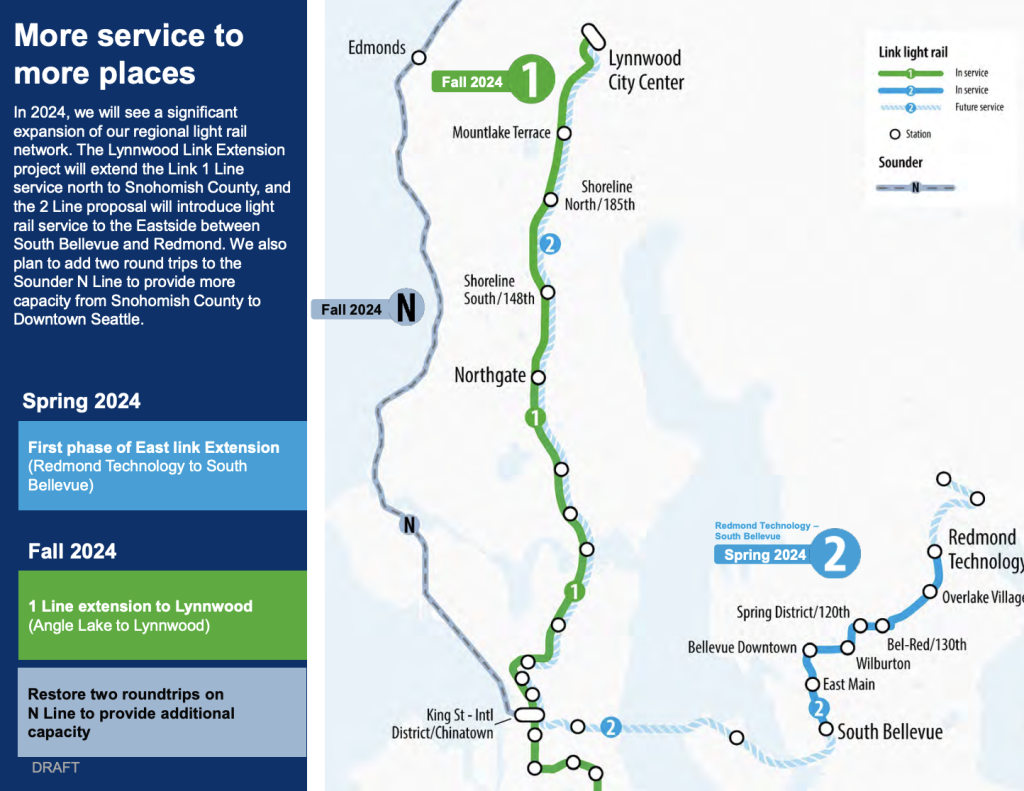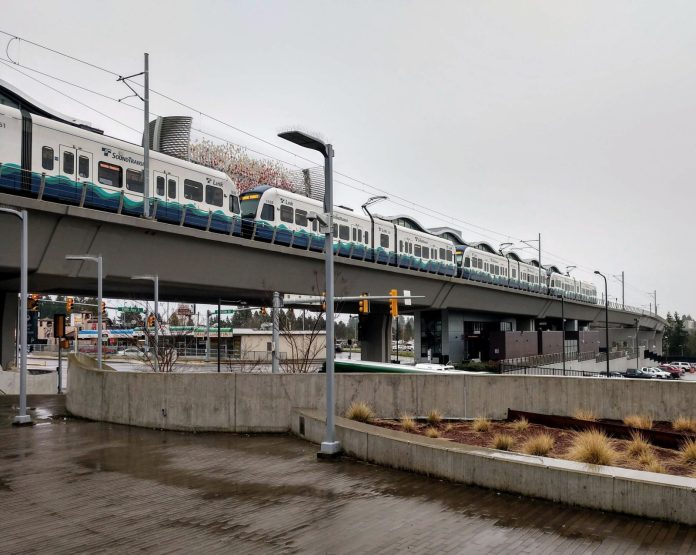
Near-term Link expansions will further strain limited resources for service capacity, forcing more crowding and lower frequencies that could last years. Can that be mitigated?
Rider demand outstripping service levels could well be a fact of life on Link once Lynnwood Link opens and for a long time after, as Sound Transit faces a period of greater constraint over the next decade. The growing pains are mostly baked in now, but agency staff have been developing strategies to reduce some of the forecasted crowding ahead.
At a recent Rider Experience and Operations Committee meeting, agency staff retraced steps from September to explain the problem. Matt Sheldon, a Sound Transit service planner, pointed back to graphs highlighting the challenges ahead and showing serious crowding during weekday afternoon periods following openings of the Lynnwood Link and Federal Way Link Extensions.
The forecasts suggest that the period of most constraint will be immediately following the Lynnwood Link Extension in 2024. When the East Link Extension fully opens, service planner expect there to be some reprieve for riders at least on the crowding front, but it will be short-lived with crowding again becoming a problem once the 1 Line service is extended to Federal Way in 2026.
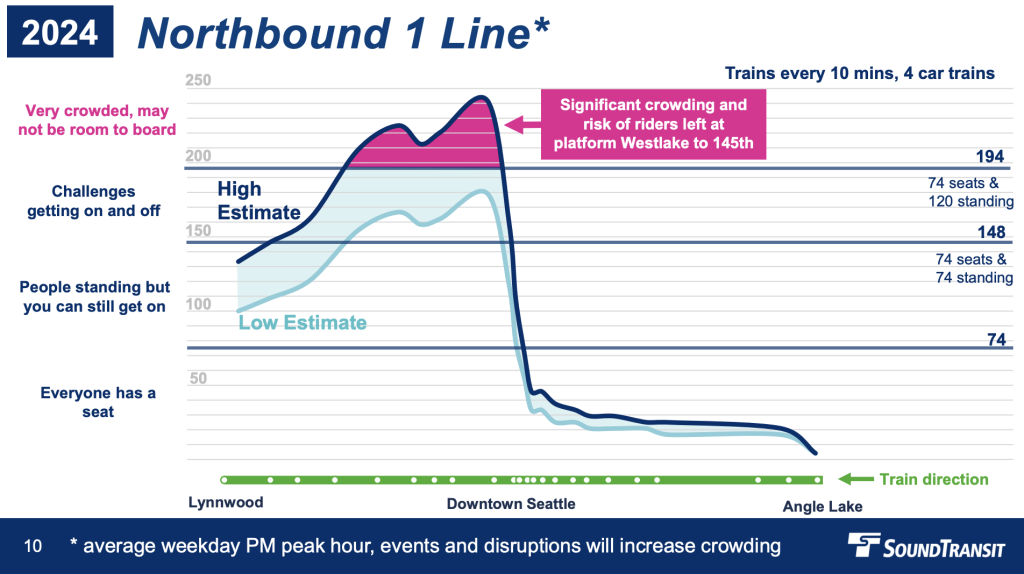
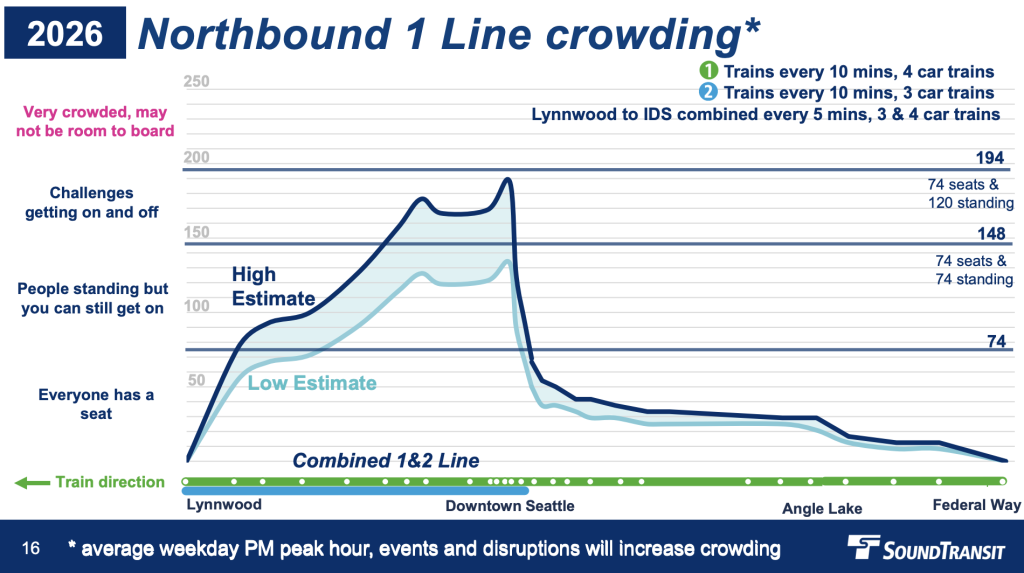
As part of Thursday’s briefing, Sheldon highlighted four strategies that the agency could use to reduce crowding. Two of the strategies were discussed last month and remain essentially the same: increasing the vehicle fleet availability rate and relieving pressure on Link by running redundant ST Express bus service.
Northgate turn-back service
A new third strategy formally entering the fray is turning back some trips at Northgate — though the agency had hinted at this earlier this year. This would involve shortening 2 Line service once East Link is able to cross I-90. 2 Line trains would terminate eight miles sooner at Northgate instead of Lynnwood. That would cover the most crowded segment of the system and ensure that all trips, whether on the 1 Line or 2 Line, would have four-car trains — increasing capacity by 14% in the segment.
The main drawbacks from a rider standpoint is that the segment from Lynnwood to Northgate would be left with 10-minute frequencies via the 1 Line instead of five-minute combined frequencies from the 1 and 2 Lines and it could affect how other transit improvements, such as the Stride S3 Line and Swift Blue Line, interface with Link. There are other more technical drawbacks, too.
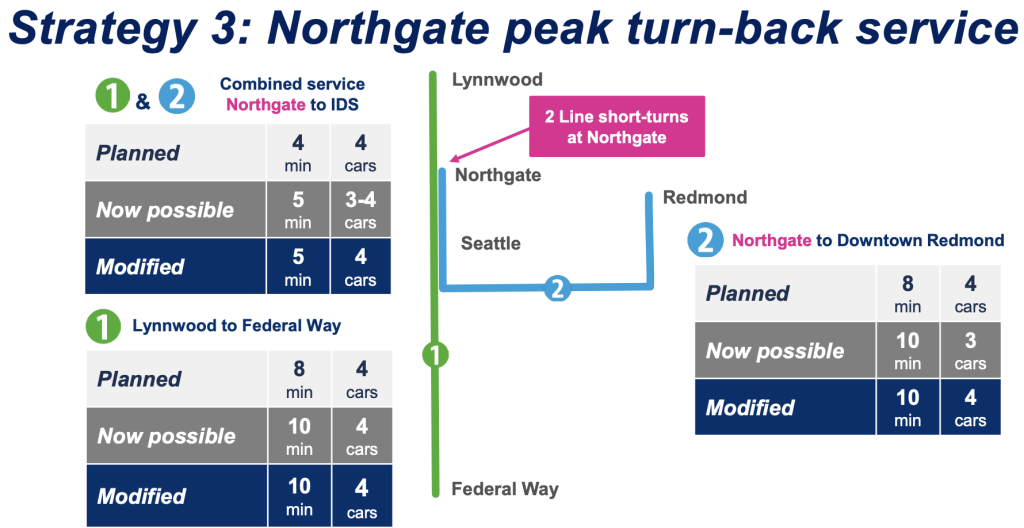
Sheldon illustrated one obstacle that many riders could face and that could create knock-on operational challenges. “Passengers coming from or going to destinations north of Northgate would either have to wait for a train to that destination or transfer to the right one after riding a train to Northgate,” he said. “This could lead passengers waiting for the right train, which could lead to uneven loads on the trains and more crowding on station platforms.”
Turning back trains could also risk gumming things up and increasing resource requirements, Sheldon explained. “Turn-back operation at Northgate would also introduce more complexity in how we run the system, which could add to delays and would require additional operators and security personnel to ensure we could turn trains around quickly at Northgate,” he said. “Turn-back operations would [further] require using the pocket track at Northgate in regular service, which would make it unavailable to store any train that might need to come out of service as we do today.”
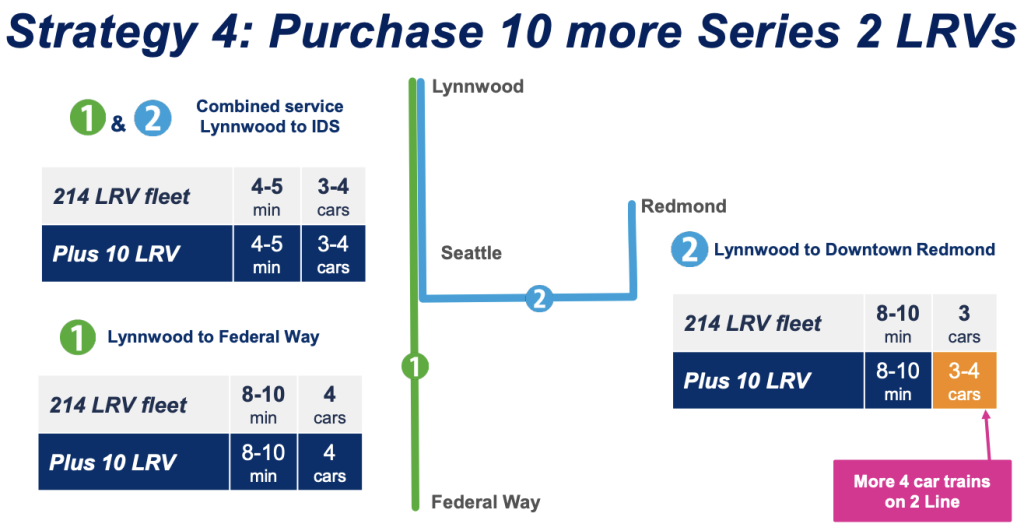
Accelerating train purchases and retained bus service
Sheldon outlined a fourth strategy, distinct from the third, that would involve purchasing additional trains sooner than anticipated and running all 1 and 2 Line service to Lynnwood. To do this, the agency would essentially accelerate some orders it would have made for Series 3 trains by buying 10 additional Series 2 cars. Sound Transit expects to see last delivery of Series 2 cars in 2027, but the extra cars could be tacked on to the current order. “Having these additional cars earlier would help us run four-car trains on the 2 Line more often, which would increase capacity on the system and help with crowding between Downtown Seattle and points north,” Sheldon said.
Sheldon issued a few words of caution on the strategy, however.
“It would require us to get creative about where we store [the extra cars] since our operations and maintenance facilities and siding tracks will be full when they arrive,” he said. “We’re looking at those opportunities right now, but we do have some more work to do to ensure that we could accommodate these vehicles.” Another issue is there would be a marginal impact on the agency’s finances, most importantly on debt capacity and debt service coverage ratio.
As for the third strategy, Sheldon didn’t offer any new information on what retaining and extending redundant ST Express bus service would look like as part of the Lynnwood Link Extension, but he did say it might be a strategy used again in the future. Sheldon specifically said that the agency could use the strategy with other Sound Transit 2 and Sound Transit 3 expansions coming down the pipeline. So perhaps that means riders may see retention of some ST Express bus routes as part of the Federal Way Link Extension.
Sound Transit-recommended strategies
Ultimately, Sheldon offered staff recommendations to the committee, suggesting that they only take up three of the four strategies: increasing fleet availability, augmenting Link with ST Express, and buying more Series 2 vehicles. “We do not, however, recommend the Northgate turn-back option due to the reduction of service north of Northgate and the complexities and the risks that kind of operation would introduce to the system,” Sheldon said.
The staff recommendation may be reasonable based upon current forecasting, but it’s an open question of how the system will actually perform in the period after the 2 Line fully opens and before — or even after — the additional Series 2 cars arrive. If severe crowding is still plaguing the system, having a turn-back strategy may be a good tool to have in the toolbox just in case. Routinely leaving riders behind on Downtown Seattle, Capitol Hill, and North Seattle platforms would be a worrying and untenable policy choice for the system.
Additional strategies worth pursuing and long-term pain for riders
Perplexingly missing from the agency-conceived strategies is taking action in the most unreliable segment of the 1 Line: Martin Luther King Jr. Way S in the Rainier Valley. Wide at-grade crossings and intersections not only risk the lives of people walking and rolling, they present a perpetual risk to Link operations with vehicle incursions into trains. Those incursions can mean extensive delays to the 1 Line and taking damaged trains out of service for extended periods of time.
Sound Transit has been slow to fund MLK Way improvements, which could include closing intersections to cars, trimming down the width of crossings, and employing other safety strategies that could buy back more frequency, four-car trains, and system reliability forever while safeguarding other users of the corridor. It’s a strategy that the Sound Transit board should push into the mix as an early action.
Fundamentally though, Link is facing a capacity problem in the expansion periods due to a confluence of issues, which include limited vehicle availability, a delayed opening to tracks on the I-90 corridor and access to the operations and maintenance facility in Bellevue, and unforced system design errors like underestimating service runtime, under-building storage capacity, and having too few Link trains to run the level of service necessary to meet demand and reach planned service levels.
As a consequence, frequencies on Link are poised to further regress to no better than every 10 minutes and many more trips could be limited to three cars instead of four per train unless mitigation strategies stem the tide. Worryingly too, Sound Transit staff have given up on six-minute frequencies for the foreseeable future — a level of service that existed only three years ago — and are even unsure about eight-minute frequencies. Beyond driving crowding issues, failure to meet promises around service levels could make passing future transit funding measures more difficult.
Altogether it could be a perfect storm for riders.
Stephen is a professional urban planner in Puget Sound with a passion for sustainable, livable, and diverse cities. He is especially interested in how policies, regulations, and programs can promote positive outcomes for communities. With stints in great cities like Bellingham and Cork, Stephen currently lives in Seattle. He primarily covers land use and transportation issues and has been with The Urbanist since 2014.

